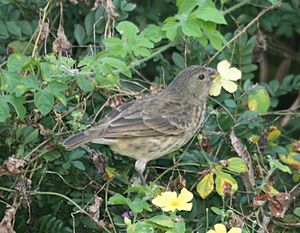Vegetarian finch facts for kids
Quick facts for kids Vegetarian finch |
|
|---|---|
 |
|
| Female | |
| Conservation status | |
| Scientific classification | |
| Genus: |
Platyspiza
|
| Species: |
crassirostris
|
 |
|
| Synonyms | |
|
Camarhynchus crassirostris (Gould, 1837) |
|
The vegetarian finch (Platyspiza crassirostris) is a special type of bird that lives only on the Galápagos Islands. It's part of a famous group called Darwin's finches. These birds belong to the tanager family, Thraupidae. The vegetarian finch is the only bird in its genus called Platyspiza.
Contents
About Its Name
The vegetarian finch is one of the birds known as Darwin's finches. These birds are a group of closely related species. They all developed on the Galápagos Islands over a long time. Their relatives, like the yellow-faced grassquit, live in other parts of America. Scientists believe an ancestor of these birds arrived on the Galápagos about 2 to 3 million years ago. The vegetarian finch was one of the first birds to develop from that ancestor.
When Charles Darwin first saw this bird in 1835, he thought it was a finch. Later, John Gould officially described it in 1837. He gave it the name Camarhynchus crassirostris. Today, the vegetarian finch is in the genus Platyspiza. This name was given by Robert Ridgway in 1897.
What Its Name Means
The name Platyspiza comes from ancient Greek words. Platus means "broad," and spiza means "finch." The second part of its scientific name, crassirostris, comes from Latin. Crassus means "heavy" or "thick," and rostris means "-billed." So, its name means "broad, thick-billed finch." The "vegetarian" part of its common name tells us what it mainly eats.
What It Looks Like
The vegetarian finch is one of the biggest finches on the Galápagos Islands. It grows to about 16 cm (6.3 in) long. It usually weighs between 29 to 40 g (1.0 to 1.4 oz). People say it stands upright, almost like a parrot.
Its beak is wide and strong. The top part of its beak has a strong curve.
- Males have olive-colored backs and whitish undersides. They have some smudgy stripes on their chest and sides. Some males might have reddish-brown on their undersides. Their lower sides and under-tail feathers are light brown. They have a black hood, throat, chest, and upper sides. Their eyes are dark. Their beak is black when they are breeding. The rest of the year, it's a horn color.
- Females are mostly brown on top and off-white underneath. They have a light brown rump and sides. Their face, head, upper body, throat, chest, and sides have brown stripes. They also have two faint light brown bars on their brown wings. Their beak has two colors. The top part is dark brown to black. The bottom part is dull orange or pink.
- Young males look like a mix of adult males and females. Their face and throat look blackish. They have more stripes on their undersides than adult males.
Voice
The song of the vegetarian finch sounds long and nasal. Each note lasts about two seconds. It sounds like ph'wheeeuuuuu-íííúúú, with the end being louder. The bird's main call is a high-pitched squeal. Some say it sounds like a radio tuner. It also makes a whiny pheep sound.
Where It Lives
The vegetarian finch lives only on the Galápagos Islands. You can find it on eight islands: San Cristóbal, Santa Cruz, Floreana, Isabela, Marchena, Santiago, Pinta, and Fernandina. It used to live on Pinzón and Santa Fé, but it's no longer there.
It lives from 0 to 500 m (0 to 1,640 ft) above sea level. It is most common in mountain forests that stay green all year. But it can also live in humid areas and dry areas.
Behavior
Reproduction
We don't know much about how these birds reproduce. They mostly breed during the wet season. They build a grassy, dome-shaped nest with an entrance on the side. During courtship and when the female is sitting on eggs, the male and female share food. They might even pass food back and forth many times.
Feeding
As its name suggests, the vegetarian finch mainly eats plants. It eats buds, leaves, flowers, and fruit. It will even peel bark off twigs to get to the soft layers underneath. While it mostly looks for food in trees, it will go to the ground. There, it searches for fallen fruits and young plant shoots. Sometimes, it also eats caterpillars.
The vegetarian finch's beak is different from other Darwin's finches that eat hard seeds. Its beak is small and strong, with a steep shape and a strong curve on the top. This beak is best for handling soft food at the tip, not for crushing hard seeds. The vegetarian finch also has a very large gizzard for its size. Its intestine is long, and its heart is quite small. These special body parts help it digest the leaves and buds that make up most of its diet.
Protecting This Bird
The vegetarian finch is not very common, but it lives across many of the Galápagos Islands. Its numbers seem to be steady. The International Union for Conservation of Nature says it is a species of "Least Concern." This means its population and living area are not small enough to be a big worry right now.
However, like all animals unique to the Galápagos Islands, human activities can affect it. Fires, too much grazing by farm animals, and new species brought to the islands are serious threats. The vegetarian finch lives in seven special bird areas on the islands.
See also
 In Spanish: Pinzón de Darwin vegetariano para niños
In Spanish: Pinzón de Darwin vegetariano para niños


